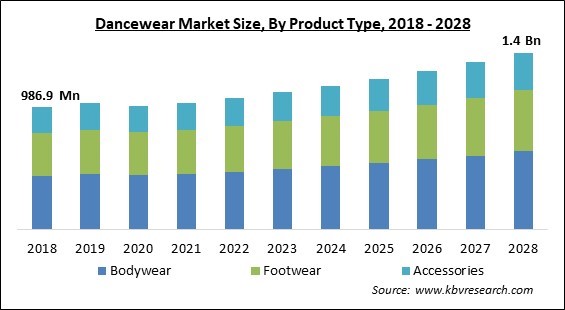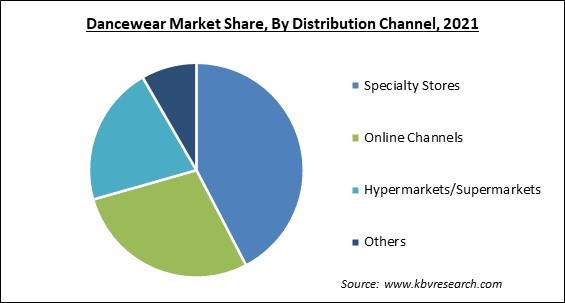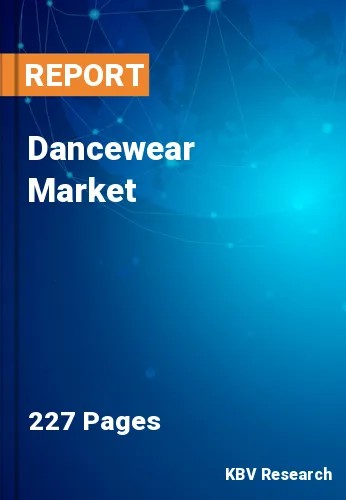The Global Dancewear Market size is expected to reach $1.4 billion by 2028, rising at a market growth of 5.0% CAGR during the forecast period.
Dancewear is a type of clothing and footwear that comes in a wide range of colors, fabrics, sizes, materials & styles to suit many dance disciplines. Dancewear is specifically designed for specific dance forms and worn at dance events & concerts. It is designed to suit aesthetic requirements while also increasing participation in the dance being performed. As a result of these reasons, demand for dancewear is increasing, resulting in a larger dancewear market.
Dancewear is a sort of apparel worn by dancers, particularly for dance performances. Dance costumes are a type of attire that can change depending on the dance form. Such costumes & dance clothes serve to suit the visual needs of the entire event while also encouraging participation in the activity. Manufacturers are introducing new forms of dancewear with a variety of fabrics and materials in response to the evolution of fashion trends & the increased emphasis on dance and its clothes and attire.
Dance shoes, dance shorts, tutus, tights, arm warmers, legwarmers, unitards, leotards, and dance belts are all examples of dancewear. The dancewear style differs depending on the type of dance. Ballet, for example, requires suitable dance clothes such as a leotard, wrap-around ballet skirt, tights, & ballet slippers. Tap dancing is a type of dance that involves tapping shoes. Leotards dancing apparel can be short-sleeved, long-sleeved, or sleeveless, and come in a variety of colors (pink or black) based on the ballet dress code. For that reason, dancewear must be breathable, stretchy, and lightweight, to allow dancers to move freely and comfortably.

The COVID-19 pandemic has wreaked havoc on global clothing supply lines. Moreover, the pandemic's impact on society & the economy has been seen as a result of global lockdowns, labor mobility restrictions, airline suspensions, travel bans, and, most importantly, an economic slowdown, all of which have seriously harmed the sustainability of apparel supply chains all over the world. Safety, training, awareness, crisis management & response, digitization, and technological innovation re-forming business models, and other unforeseen effects have all been added to the worldwide clothing & fashion sector as a result of COVID-19.
Dancewear in a broad range of vibrant colors, geometric designs, printed designs, enhanced fabric flexibility & comfort, ballet dancewear, personalization of costumes, likewise designs to those worn by mainstream dancers, & the availability of several artist collections has all emerged as new trends in the training dancewear market. In addition, as the popularity of Zumba as a form of exercise grows, more individuals are taking part in fitness programs involving soca, salsa, hip-hop, mambo, samba, and merengue. As a result, the market expansion is likely to pick up during the projection period. Numerous dance styles, like salsa, ballets, samba, rumba, and different ballroom dance forms, like quickstep, waltz, foxtrot, & others, are also being taught in schools to assist kids to relieve tension, anxiety, and increase confidence.
The most important trait a dancer should possess is flexibility. The dancer will have the most flexibility and control over their motions and body if they wear a branded and comfortable dancing costume. It also aids people in becoming the best dancers by providing a high level of affability. Dancewear are designed to serve this purpose efficiently. In any category, another important quality is comfort. Dancers while wearing a dancewear must always feel at ease working and finishing the work they choose and having the best-branded dancing outfit will provide the dancers with the most comfort while performing.
The easy availability of counterfeit products, on the other hand, has an impact on the broader garment sector and specifically the dancewear market's growth. Further, they have a tremendously negative impact on businesses, as premium brands are distinguished by their prestige as well as the limited quantity available. Counterfeits pollute the supply with similar-looking, lower-quality things that aren't made with the same care. In a variety of ways, businesses are harmed by a shortage of IPR (Intellectual Property Rights) protection. Not only is there a direct loss of revenue, but there is also a loss of brand image.

Based on Product Type, the market is segmented into Bodywear, Footwear, and Accessories. The accessories segment garnered a significant revenue share in the dancewear market in 2021. Dance props and equipment are among the many elements that can be used to enhance performance. Hairpieces, belts, poms, caps, headbands, gowns, jewels, & streamers are just a few kinds of accessories. While most accessories aren't necessary for being a competent dancer, they are frequently used to improve comfort and elegance. Bags, headbands, jewelry, ribbons, music players & other dancing accessories are among the most frequently utilized.
Based on Distribution Channel, the market is segmented into Specialty Stores, Online Channels, Hypermarkets/Supermarkets, and Others. The specialty stores segment acquired the highest revenue share in the dancewear market in 2021. The development occurred, owing to the greater availability of high-quality dancewear products that draw customers to specialty stores. As an outcome, dancewear sales in specialty stores are higher than those in other distribution channels.
Based on End-user, the market is segmented into Women, Men, and Children. The men segment procured a substantial revenue share in the dancewear market in 2021. Any instructor will swear that dance improves an individual in more ways than just physical health; the social & psychological benefits are likely even more useful because they apply to real-life situations. Thus, many men are increasingly turning to dance for fitness reasons. The patience & devotion required to learn a dance routine is immense. These are vital lessons that young males, like young girls, require. Those in the know are well aware of how demanding and time-consuming dance can be. Participants improve their body conditioning not just in terms of anaerobic capability but also in terms of muscle development.
Based on Application, the market is segmented into Concerts, Theatre, Entertainment Industry, and Others. The other segment procured a substantial revenue share in the dancewear market in 2021. Consumers who wear dancewear at school, universities, and public institutions are under the other segment. The demand for dancewear has increased as the number of annual events, dance competitions, & other regular activities at universities has increased. Social dance & participation dance, on the other hand, can be performed without an audience & are often neither choreographed nor danced to music, but there are exceptions. Some ceremonial & baroque dances, for instance, combine concert & participation dancing by having participants take on the roles of performer & audience at different times.
| Report Attribute | Details |
|---|---|
| Market size value in 2021 | USD 996.7 Million |
| Market size forecast in 2028 | USD 1.4 Billion |
| Base Year | 2021 |
| Historical Period | 2018 to 2020 |
| Forecast Period | 2022 to 2028 |
| Revenue Growth Rate | CAGR of 5% from 2022 to 2028 |
| Number of Pages | 227 |
| Number of Tables | 459 |
| Report coverage | Market Trends, Revenue Estimation and Forecast, Segmentation Analysis, Regional and Country Breakdown, Companies Strategic Developments, Company Profiling |
| Segments covered | Product Type, Distribution Channel, Application, End-user, Region |
| Country scope | US, Canada, Mexico, Germany, UK, France, Russia, Spain, Italy, China, Japan, India, South Korea, Singapore, Malaysia, Brazil, Argentina, UAE, Saudi Arabia, South Africa, Nigeria |
| Growth Drivers |
|
| Restraints |
|
Based on Regions, the market is segmented into North America, Europe, Asia Pacific, and Latin America, Middle East & Africa. The North American region acquired the largest revenue share in the dancewear market in 2021.This trend is likely to continue till the year 2024.The market's domination is partly attributable to the prevalence of dance schools, as well as an increase in the number of events and performances produced to persuade audiences to acquire trendy dancewear and incorporate dancing into their everyday routines.
Free Valuable Insights: Global Dancewear Market size to reach USD 1.4 Billion by 2028
The market research report covers the analysis of key stake holders of the market. Key companies profiled in the report include ONWARD HOLDINGS Co., Ltd., Revolution Dancewear LLC, SF Dance Gear, Wear Moi Sas, Ballet Makers, Inc., BLOCH UK Ltd., Bullet Pointe, Flo Dancewear, and Grishko Dance s.r.o.
By Product Type
By Distribution Channel
By End-user
By Application
By Geography
The global dancewear market size is expected to reach $1.4 billion by 2028.
The growing trend of training dancewear are increasing are driving the market in coming years, however, the presence of counterfeits is constraining the growth of the market.
ONWARD HOLDINGS Co., Ltd., Revolution Dancewear LLC, SF Dance Gear, Wear Moi Sas, Ballet Makers, Inc., BLOCH UK Ltd., Bullet Pointe, Flo Dancewear, and Grishko Dance s.r.o.
The Bodywear segment acquired maximum revenue share in the Global Dancewear Market by Product Type in 2021, thereby, achieving a market value of $632.4 million by 2028.
The Women segment is leading the Global Dancewear Market by End-user in 2021, thereby, achieving a market value of $743.8 million by 2028.
The North America is the fastest growing region in the Global Dancewear Market by Region in 2021.
Our team of dedicated experts can provide you with attractive expansion opportunities for your business.

